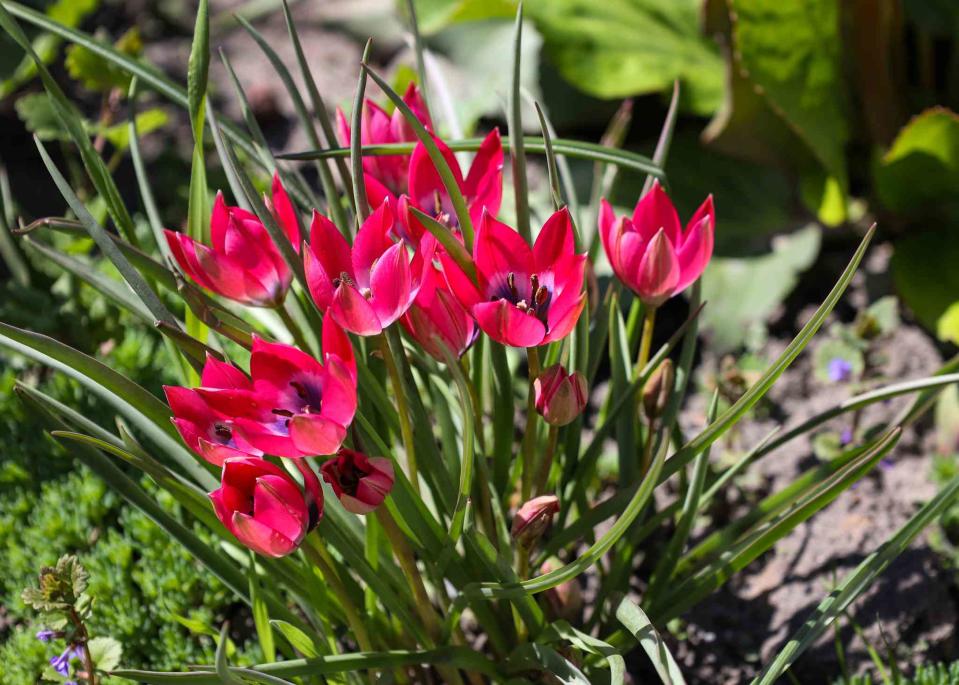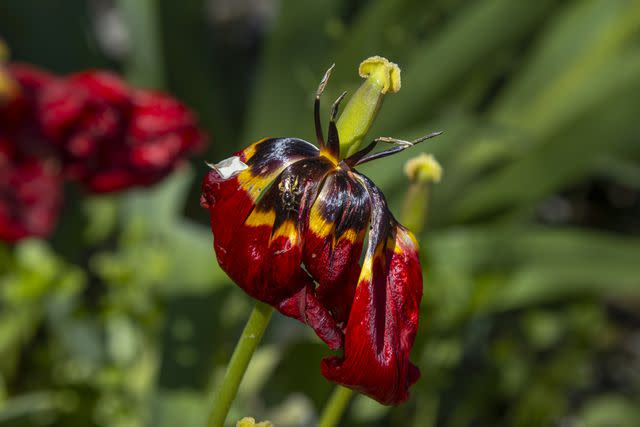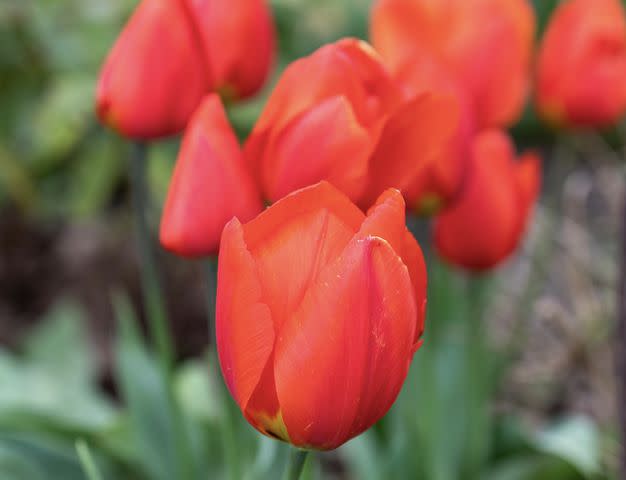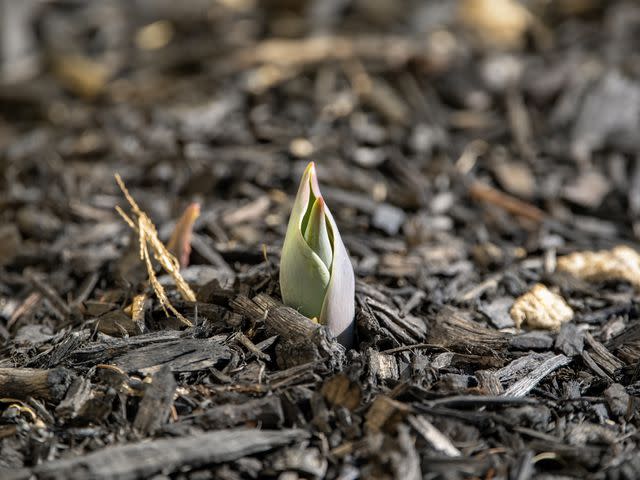Are Tulips Annuals or Perennials? Here's What to Know
Here's how to make tulip bulbs bloom this spring

Tetiana Kolubai / Getty Images
If you are new to planting tulips, you might have heard that they dependably come back every year, but that isn't always the case. You need to plant perennial tulip varieties, which pop back up season after season for beautiful spring blooms.
Although tulips were originally perennial bulbs, most of the tulips sold in the nursery trade today are treated by gardeners as annuals. However, there are many perennial tulip types that you can plant, and several tasks to make your tulips last for more than one season.
Read on to learn all about perennializing tulips.
Are Tulips Annuals or Perennials?

Tulips can be grown as annuals or perennials, depending on the location. To grow tulips as perennials, they need an extended period of consistently cold temperatures, which allows the bulbs to develop a strong root system and flower the next spring. In the United States, only USDA zones 3 to 7 provide the necessary conditions to grow tulips as perennials.
In USDA zone 8 and above, where winter temperatures are on average ten degrees warmer than in zone 7, they can only be grown as annuals and need to be replanted every year.
The majority of the more than 3,000 tulip varieties available today are hybrids that were bred to be grown as annuals. Growing tulips as perennials requires not only suitable growing conditions with cold winters, but also planting tulip varieties that last more than one year.
Even in ideal conditions, two to three years is the limit for perennial tulips. Also, keep in mind that the life of tulips is often cut short by hungry squirrels and other critters.
How to Encourage Regrowth from Tulips

Elenakirey / Getty Images
If you live in USDA zones 3 to 7, perennializing tulips is a straightforward and fairly simple process.
After the bloom, remove the spent flowers before they turn into seeds but leave the foliage untouched—it needs to die, wither, and dry out naturally. This exposes the plant to the maximum period of photosynthesis and strengthens the bulb.
It may take until June or July for the foliage to completely die. At that point, you can safely remove the foliage.
Dig up the bulbs and store them after the foliage has died back.
Trim the dead foliage and wipe them clean, then store the bulbs in a well-aired place between 60 and 70 degrees F until the fall, then replant them.
While this moves the bulbs out of the reach of critters, it is not conducive to the growth of the bulbs—not disturbing the tulips increases their chance of naturalizing.
Growing Tulips in Warm Climates

AlexWonderPic / Getty Images
Emperor tulips (Tulipa fosteriana)Growing tulips as perennials in USDA zones 8 and above requires some finagling, as the winter temperatures are not consistently cold enough for the bulbs. The workaround is to dig up the bulbs after the bloom and subject them to an 8- to 12-week chilling period.
The process of digging up the bulbs and storing them over the summer is the same as above. However, the subsequent prechilling is tricky. Bulbs need to undergo at least 8 weeks of prechilling at temperatures between 35 and 48 degrees F.
How to Mimic "Overwintering" Tulip Bulbs
For most home gardeners, the refrigerator is the place that offers this environment, though not without challenges. The bulbs can dry out or mold if there is excess moisture.
A perforated plastic bag lets some air in and somewhat protects the bulbs from drying out. Don’t place the bulbs in the crisper drawer, as the ethylene from many fruits and vegetables causes the bulbs to rot.
When it's time to plant, take the bulbs out of their cold storage and let them warm up for a few hours before planting.
Tip
It is usually easier to purchase prechilled bulbs every year. Nurseries prechill the bulbs in a temperature- and moisture-controlled environment, so you have a much better chance of seeing blooming tulips in the spring than trying to replicate the process yourself.
5 Types of Perennial Tulip Bulbs to Plant

Ali Majdfar / Getty Images
Below is just a small selection of perennial tulip varieties. Before purchasing bulbs, check if they are recommended as perennial tulips.
Species tulips, also known as wild tulips, are smaller and more delicate than and reliably perennial. Popular species and cultivars include Tulip clusiana ‘Lady Jane’ and ‘Honky Tonk’; Turkestanica tulip (T. turkestanica); T. humilis ‘Helene’; T. pulchella, a dwarf species; and T. tarda.
Kaufmannia hybrid tulips such as 'Showwinner' are low-growing tulips that work well in rock gardens and borders. They may naturalize if left undisturbed.
Greigii tulips (T. greigii) are perennials for northern locations; the bulbs tend not to last in summer temperatures above 70 degrees F.
Giant Darwin hybrid tulips have large flowers in vibrant colors and strong stems. Recommended perennial varieties include ‘Gudoshnik’ and ‘Ivory Floradale’.
Emperor tulips, also known as Fosteriana tulips, are descended from T. fosteriana, a wild tulip from Central Asia. A popular variety for perennial growing is ‘Red Emperor’ and ‘Exotic Emperor’.
Our Best Care Tips for Tulips
Purchase large, good-quality bulbs from a reputable source and choose a variety that is described as lasting for more than one season.
Select a location with at least 5 to 6 hours of full sun, loosely textured or sandy soil, and excellent drainage.
Plant the tulips in the fall after the soil temperature has dropped. Adjust the planting time according to the USDA zone of your location.
As for the planting depth, plant the bulbs at least three times as deep as the bulb height, preferably 1 or 2 inches deeper, which encourages reblooming.
In the fall, cover the planting area with 2 to 3 inches of hardwood mulch to insulate the bulbs from the cold. Remove the mulch promptly when the weather warms up in the spring.
Fertilize the bulbs with a granular, slow-release, high-phosphorus organic fertilizer, such as 3-5-3, in the fall when the bulbs are growing new roots.
Never cut perennial tulips for bouquets. If you want tulips for a bouquet, plant some annual tulips exclusively for cutting.
Frequently Asked Questions
Can you leave tulip bulbs in the ground all year?
You can leave the bulbs in the ground all year if you live in a climate with cold winters (USDA zone 7 or below), which fulfills the chilling requirements of the bulbs. There is no guarantee the tulips will bloom for a second year, but since they don’t do any harm sitting in the soil, it’s worth trying.
What do you do with tulips after they bloom?
After the bloom, the only thing you need to do is remove the spent flowers, so they don’t set seeds, which is an unnecessary waste of the plant’s energy. Other than that, wait until the foliage has died back completely before removing it.
Do tulips come back and multiply?
Most tulips are annuals and won’t come back, it depends on the variety. Also, even those that come back often don’t multiply as reliably as other spring bulbs. Sometimes a bulb produces smaller bulbs, which take years to grow to a size where it flowers.
Read the original article on The Spruce.

